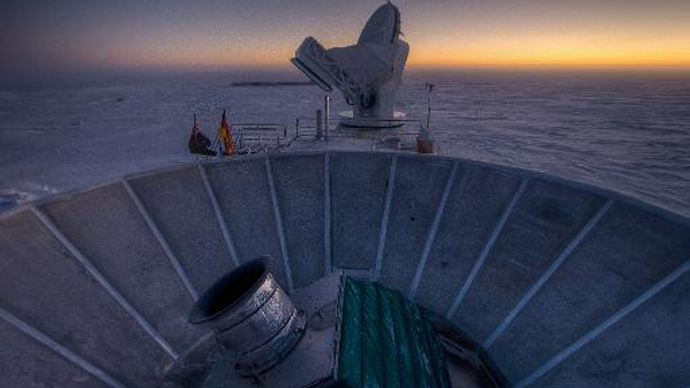Discovery of rapid ‘cosmic inflation’ boosts Big Bang theory

Scientists have detected the first direct proof of cosmic inflation, a theory that the universe expanded by 100 trillion trillion times just after the Big Bang. If confirmed, the discovery marks a major point in understanding the universe's origins.
Around 14 billion years ago, waves of gravity rapidly pulsated through space immediately following the Big Bang, experts announced Monday at the Harvard-Smithsonian Center for Astrophysics.
Cosmic inflation was predicted by Albert Einstein’s theory of general relativity, but proof of the “first tremors of the Big Bang” provides an important connection to his work and the more enigmatic field of quantum mechanics.
The researchers stationed a telescope called BICEP2 in the South Pole which eventually found evidence of the oldest light in the universe, AFP reported.
BICEP2 was aimed at the “Southern Hole” beyond the galaxy where there is a low amount of dust or other extra galactic material that can obscure sight lines.
At a strength of 1016 gigaelectronvolts - higher than the researchers expected - the telescope detected small fluctuations in light waves within the hazy microwave glow left from the Big Bang. The gravitational waves reach back to just 380,000 years after the Big Bang, when the universe exploded in all directions from a single point of infinitely dense energy.
"The CMB (cosmic microwave background) is a snapshot of the Universe 380,000 years after the big bang, when the radiation first streamed freely into space," head researcher John Kovac said in an interview with Nature. "But the gravitational-wave signal was imprinted on the CMB a tiny fraction of a second after the birth of the Universe."
Kovac said years of observations led to Monday’s announcement.
"Detecting this signal is one of the most important goals in cosmology today. A lot of work by a lot of people has led up to this point,” he said, adding his team analyzed the data for three years to ensure its validity.
The project included researchers from the likes of the University of Minnesota, Stanford University, the California Institute of Technology, and NASA's Jet Propulsion Laboratory, in addition to the Harvard-Smithsonian Center of Astrophysics.
NASA said the data "not only help confirm that the universe inflated dramatically, but are providing theorists with the first clues about the exotic forces that drove space and time apart."
Harvard theorist Avi Loeb told AFP the findings offer "new insights into some of our most basic questions: Why do we exist? How did the universe begin?”
"These results are not only a smoking gun for inflation, they also tell us when inflation took place and how powerful the process was," Loeb said.














